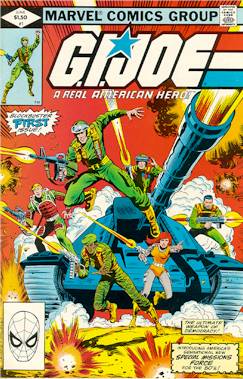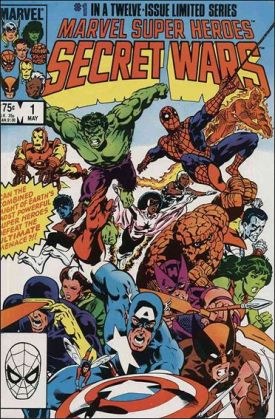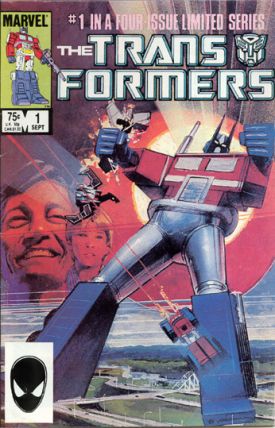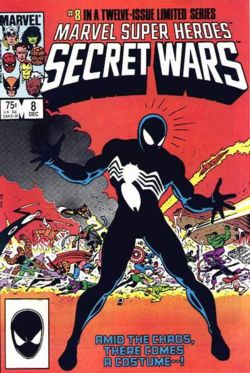Comics /
Spotlight /
Knowledge and Scholarship
Marvel History Part 5 - The 1980s
By Frederic Haddox
August 2, 2008 - 21:11
In the 1980’s, America was experiencing a renaissance in music, art and culture. Marvel Publications at this time were definitely in sync with this modern movement. In 1983, film audiences saw the last of the
Star Wars instalments entitled
The Return of the Jedi. It was eminent that readership of
Star Wars would decrease. Marvel Comics adeptly filled this possible void by publishing a new series. Instead of publishing a comic book that was rendition of a film, Marvel Comics produced an animated series that was a rendition of their comic. Marvel released
GI-Joe: A Real American Hero. The comic series was created in the spirit of the war comic books from the golden age, an action figure toy line as well as
St. Fury and his Howling Commandos; which was published by Marvel Comics in the 1960s. The comic series, which was complimented with a toy line by Hasbro, proved instantly successful. Soon the
GI-Joe animated series was released by Marvel Productions.
 |
In 1981, Marvel Comics purchased the DePatie-Freleng Enterprises Animation Studio (famous for
Pink Panther) and renamed it Marvel Productions. [1] Having already produced
The New Fantastic Four in 1978 and
Spiderwoman in 1979, the renamed studio released a
Spider-man and
Incredible Hulk series. [7]
Soon after
GI-Joe’s debut,
The Transformers were released. This series, which was also fortified with a popular toy line by Hasbro, would prove even more popular than
GI-Joe. Marvel Productions released other animation serials such as
Dungeons and Dragon,
Muppet Babies and
Spider-man and Friends. The last title in particular was useful in presenting various Marvel Comics characters that were unknown to popular audiences. Furthering the exposure of different characters to readers and potential readers seemed to be the driving force behind the company’s marketing in the second half of the 1980s and early 1990s.
The
What if and
Marvel Team Up series were two such titles which helped accomplish this. The
What If series, published from 1977-1984, presented unreal events featuring Marvel characters. An alien space traveller, known as the Watcher, tells the consequences of a supposed event that took place in the life a superhero or heroes. This was a particularly good way of introducing the origins of new characters to readers.
Marvel Team-Up, published from 1972-1985, featured two characters featured together in one story. [9] Although the issue normally featured Spider-man, different Marvel Characters were always introduced. The success of
Spider-man versus Superman brought about the publication of
Batman versus Hulk and
X-Men and the Teen Titans. Both DC and Marvel Comics’ collaborations were popular and helped sales. The mini-series was another technique to create greater exposure of Marvel Comics characters. On average, these stories lasted two to six issues. They helped gained popularity for characters such as Punisher, Wolverine, Nick Fury and Hawkeye. A reader could more easily “divert” from their normal reading and quickly gain more awareness of a different story. The character collaboration and the mini series combined and took the form of the “crossover.”
After
Marvel Team-up and the
What If series ended the crossover quickly gained momentum. Jim Shooter seemed to favor the crossover, which seemed to accomplish so many goals in one swift stroke. [1]
Marvel Super heroes Contest of the Champions and
Secret Wars were key catalysts in introducing the crossover.
Contest of the Champions, a three-issue series published in 1982, brought together most of the super heroes of Marvel Comics and made them compete in two groups to find pieces to a “golden globe of life.” [10]
Secret Wars brought many of the most popular characters to a deserted planet where they would be forced to survive. Under the watch of a mysterious deity called the Beyonder, the characters often had to fight with each other.
Secret Wars proved popular enough to even have its own toy line. This series was unique because it lasted twelve issues and directly tied these characters to each other. Even though the series did affect normal Marvel storylines during and after its completion,
Secret Wars didn’t contain any true crossover storylines.
The sequel,
Secret Wars 2, not only had a length of twelve issues, but its stories were tied directed to over 30 other comic book issues. [11] This crossover made readers buy other titles they normally wouldn’t, in order to find out the end of the story.
Because of their growing popularity, the number of mutants increased throughout the decade. Characters such as
Kitty Pryde, Dazzler, Rogue, Rachel (the new Phoenix), Longshot and Gambit were added to the storylines as well as given series of their own. Reader’s also had a choice of new group titles as well.
The New Mutants, a comic about a group of child mutants, was considered one of the more original titles to emerge during the 1980s. Alpha Flight had a title. X-Factor was a regrouping of the original X-Men. Excalibur was another regrouping of popular mutants. This trend would continue into the 1990s with even more characters.
Marvel Comics attempted to present readers with a series of books collectively called
The New Universe in 1986. These titles were completely separated from the mainstream Marvel Universe and gave readers something new to be a part of. Unfortunately the titles failed to prove popular and were discontinued before long.
Spider-man, once again, seemed to experience the most change in the in 1980s. In the mid 1980’s, Parker Brother’s released a Spider-man video game for the Atari 2600 and Mattel Intellivision home video game systems. This early entrance into the electronic game market was wise. The growth of popularity in video games and Marvel Comics’ characters could easily complement each other.
In 1985, Spider-man’s normal
Marvel Team Up series was replaced by the
Web of Spider-man. Two years later in
Amazing Spider-man Annual #21, Peter Parker was married to Mary Jane Watson; Parker’s consistent love interest. Marvel Comics offered two issues with different covers commemorating the event. The practice of offering multiple covers would later prove a commonplace in comic books.
Spider-man #252 introduced the infamous “black outfit.” Being the first major physical alteration in Spider-man’s appearance, the series attracted many people who bored with the character. Another milestone occurred when Todd McFarlane took over the Spider-man storyline in issue #298. McFarlane, who already brought the Hulk back to his original grey look, tried to bring Spider-man back to its roots. By the end of McFarlane’s issue with Spider-man, the black costume was removed and Parker would return to the original blue and red. A common theme to McFarlane’s work is always the animation of the costume. He soon gave the black costume its own identity as an alien life form; (which was first introduced in
Secret Wars #8). This character known as “Venom” would become the new arch rival to Spider-man. Despite the adjustment of his physical appearance, the largest change was the character itself. Less distance was made between Parker and his alter ego. Peter’s awkwardness and self-doubt was more illustrated in Spider-man’s actions. This design on Spider-man has been used as a blue print for most artists who’ve illustrated him even to this day.
References
1. ^Wikepedia, the free encylopedia: “Marvel Comics”
7. ^International Catalogue of Super heroes: “Cartoons based on Marvel Characters”
9. ^Wikepedia, the free encylopedia: “Marvel Team-Up”
10. ^Wikepedia, the free encylopedia: “Contest of the Champions”
11. ^Wikepedia, the free encylopedia: “Secret Wars2”
Last Updated: January 17, 2025 - 08:20



